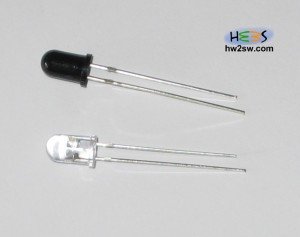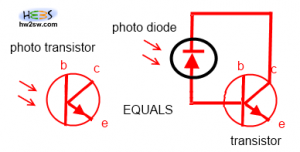
An IR Led emitter combined with an IR receiver can make an opto-isolator.
By using an opto isolator we can transfer information between circuits without an electrical connection.
In opto isolators the emitter is always an IR LED.
The receiver can be a photo-diode or a photo-transistor.
Photo transistors are transistors using the base as "light" sensor. When light strikes the photo transistor's base, it will conduct otherwise it will insulate.
Photo-diodes, on the other hand, are semiconductors that produce current flow when they absorb light.
There are two types of photo-diodes the photovoltaics and the photoconductors.
The photovoltaics when they absorb light create a voltage difference between the edges.
Photoconductors are reverse biased photo diodes. When they absorb light the reverse biased resistance will decrease.
Notice that a photo-transistor is nothing else than a reverse biased photo-diode + a normal transistor.
